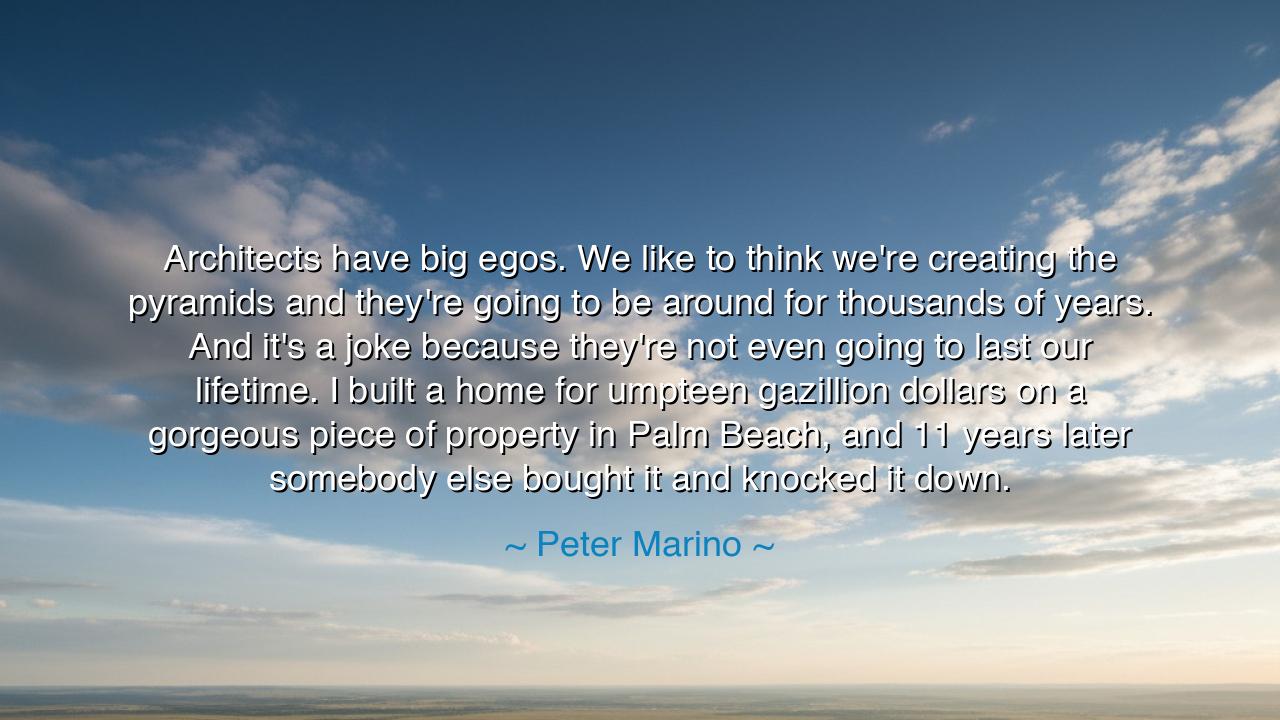
Architects have big egos. We like to think we're creating the
Architects have big egos. We like to think we're creating the pyramids and they're going to be around for thousands of years. And it's a joke because they're not even going to last our lifetime. I built a home for umpteen gazillion dollars on a gorgeous piece of property in Palm Beach, and 11 years later somebody else bought it and knocked it down.






In the sunlit courts where builders once pledged stone to the gods, a wry admonition sounds from Peter Marino: “Architects have big egos. We like to think we’re creating the pyramids and they’re going to be around for thousands of years. And it’s a joke because they’re not even going to last our lifetime. I built a home for umpteen gazillion dollars on a gorgeous piece of property in Palm Beach, and 11 years later somebody else bought it and knocked it down.” Hear the irony wrapped in humility: the hand that shapes grandeur also learns how quickly grandeur is unmade. The chisel rings, the ribbon is cut, the champagne sighs—and the market, implacable as weather, erases the footprint as if to whisper, “Dust is your client too.”
The saying cuts two ways. First, it rebukes the fever of immortality that haunts craft. We dream of stone that defies the calendar, of cornices teaching our names to unborn mouths. Yet the truth stands like an unsheathed plumb line: permanence is borrowed, never owned. Even the pyramids—icons of endurance—are not immortal; they weather, they shed, they wait upon human stewardship. The second cut is merciful: once we lay down the idol of forever, we can serve the present with honest hands. To build becomes an act of care rather than conquest.
Consider a tale of splendor unspooled: Penn Station in New York, a Beaux-Arts cathedral of iron and light, raised at the dawn of the twentieth century, crowned with eagles, flooded with day. Its makers surely believed they had given a city a centuries-long heart. Yet in 1963 the wreckers came, carts groaning with the bones of a dream. The demolition shocked a nation and birthed preservation laws—but the building itself was gone. If a palace of vaults and granite can vanish within a lifetime, who will swear that a mansion in Palm Beach shall endure beyond 11 years? The ledger of time is not balanced by cost.
The ancients knew this lesson—though they spoke it softly. The Parthenon became a church, then a mosque, then a ruin blown open by powder; Rome’s temples wore new faces as basilicas; empires quarried yesterday’s triumphs into tomorrow’s steps. The moral is neither despair nor cynicism; it is sobriety. What endures is not only the wall, but the wisdom that framed it, the craft that can build again after loss, the civic will that decides what is kept and what is allowed to fall.
Marino’s confession about the house “for umpteen gazillion dollars” lays bare the modern pantheon: not deities, but caprice—of clients, codes, fashion, and finance. In such a world, the architect’s oath must widen: beyond form to stewardship, beyond signature to service. Beauty is still a duty; so is adaptability. If a work may be knocked down, let it at least leave the earth better than it found it—through materials chosen wisely, ecosystems mended, communities knit, craftsmen trained, apprentices equipped to carry the fire.
What, then, is the lesson we pass to the next guild of makers? Temper ambition with ash from the censer of time. Let your pride be not in how long your name is carved, but in how well people lived beneath your roof. Build for repair, not for idolatry; for change, not for panic; for delight, not for vanity. Measure success not by whether a thing lasts thousands of years, but by whether it dignifies the years it is given.
Practical rites for the work: (1) Design for disassembly—so that when endings come, materials return to life rather than to landfill. (2) Choose durability where it serves people, not ego; a quiet hinge that survives children is nobler than a loud façade that survives critics. (3) Document clearly and teach generously; let your drawings be manuals for those who will mend or replace what you began. (4) Embed flexibility—rooms that can change use, grids that welcome new skins. (5) Seek civic covenant: partner with neighbors, historians, and ecologists, so that preservation—when deserved—has allies ready. And when the hour of demolition sounds despite all counsel, stand without bitterness: salute the seasons, pocket your tools, and begin anew. For the wise builder knows that greatness is not merely to be remembered, but to be repeatable—and that the truest monument is a practiced hand, steady, humble, and ready for the next foundation.






AAdministratorAdministrator
Welcome, honored guests. Please leave a comment, we will respond soon